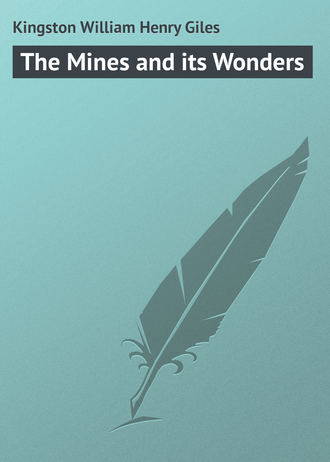 полная версия
полная версияThe Mines and its Wonders
A romantic incident is connected with this mine. In the year 1719, while some miners were exploring an abandoned passage, they discovered a human body, preserved from corruption by the blue vitriol or sulphate of copper produced in the mine under the influence of the atmosphere and water. It was that of a handsome young man. On being brought to the surface, people from all directions flocked to see it, but nobody could recognise in its features a lost kinsman or friend. At length a woman, with tottering steps, upwards of eighty years of age, approached the corpse, when scarcely had she cast a glance at it than she uttered a piercing shriek, and exclaimed, – “It is he! It is Gustavus, for whom I have mourned so long, whom I accused of fickleness in deserting me.”
She had in truth recognised her affianced lover, who had mysteriously disappeared more than sixty years previously, but whose image she still bore in her memory. As he was not employed in the mines, no one thought of searching for him underground. The surface is traversed by various crevices, some leading to the workings underground; and probably Gustavus, prompted by curiosity, had looked down one of them, and had either, losing his balance, fallen in, or been precipitated by some jealous rival in the good graces of the once blooming girl, now a tottering old woman, weighed down with a double burden of infirmity and age. She probably forgot how years had passed away, as she gazed once more on the face of her youthful and handsome lover.
Besides copper, Sweden produces iron of great excellence, won from its celebrated mines of Dannemora, and largely imported into England for the manufacture of steel.
Leaving the university town of Upsala, and passing through a natural barrier of forests and lakes, in which lie the iron-works of Oesterby, the travellers reached the place in which the pit of Dannemora is situated; not a sign announced the vicinity of the mine, until they saw the machines for lifting the ore, and a few huts scattered about, when they found themselves standing on the brink of a vast pit or crater, whose black and precipitous walls fence an abyss of a mile in circumference, and a depth of 450 feet. Here and there in that cold region they perceived patches of perennial snow and along the black walls, the dark entrance to labyrinthine caves fringed with long stalactites of ice. In some of these hollows flames were seen creeping along the cliff as they issued from piles of fir wood to soften the hard rock, while on every part of the deep gulf human beings were at work, the clang of their hammers sounding like the clicking of numberless clocks, mingled with the creaking of machinery, which brings to the surface the casks of ore. At length a bell tolled, and men, women, and children were seen ascending in the tubs, some standing on the edges, holding on with perfect confidence to the rope by which they were hoisted up.
Silence now reigned below, except when the voices of overseers were heard summoning those who had lagged behind, to ascend in haste. Scarcely had they reached the upper surface when a loud thundering roar was heard, which echoed through the cavern. The ground trembled as if convulsed by an earthquake, while black masses of smoke with pieces of stone or ore ascended from the gulf, and the crashing sound of falling masses rent from the mother earth was heard. When all the charges had exploded, the miners again descended to their work.
Although it cannot be classed among the wonders of the subterranean world, the famous Erzgebirge or iron mountain in the Styrian Alps deserves mention. It rises to the height of 3000 feet, the whole being coated with a thin mantle of the richest ore. In all directions it is covered with machines of various forms, horizontal and vertical galleries, tunnels and roads, and represents, as it were, a mine turned inside out. The whole of the operations are exposed to view, like those in the Carclaze tin mine in Cornwall, only in the former the ore is conveyed by tram-roads, galleries, and shafts to the bottom of the mountain, where they all unite in one main shaft, from which a tramway runs to the smelting-ovens of Eisenerz and Vordernberg.
Among the beautiful productions of nature, rock-crystal may be classed, known as the false topaz when yellow, the morion when black, and the smoky quartz when brown. The colourless kinds are often called Bristol or Irish diamonds, and the violet the amethyst. Some few years ago, a party of tourists, led by a guide, Peter Sulzer, set out from Guttannew, in Switzerland. When descending the mountain they reached a dark cavity, out of which they extracted some pieces of black rock-crystal with the handles of their Alpine stocks. The following year, Sulzer and his son, with a few companions, made an attempt to force their way into the cave, by widening the entrance with gunpowder. In spite of hail, rain, and bitter cold, they persevered, remaining during the night close to the cavern, in order to renew their labours the next morning.
Having widened the entrance, they penetrated to a considerable depth into the mountain, through a large cave piled up with débris, in which were embedded large planes of jet-black morions. These beautiful crystals had grown originally from the sides or roof, and had either fallen from their own weight, or been shaken out by some convulsion of nature. Their toil was rewarded by upwards of a thousand large crystals, varying from fifty pounds to more than three hundredweight.
Their expedition and its result becoming known, the whole population of Guttannew turned out with hammers, spades, and baskets, to carry off what they had left. As it was reported that the Government intended to interfere, they laboured night and day for a week, until, by the time the authorities arrived from Ijri, the whole had been removed. Some of the finest specimens are still to be seen in the museum at Berne.
Amber, about which all sorts of fabulous stories have passed current, is found more frequently in the depths of the sea than in those of the earth. There can be no doubt that it is the product of several conifers, or cone-bearing trees, overwhelmed by the waves. Although the gum which exuded from them has remained concealed for ages, until washed up from the bottom of the ocean, flies and spiders, which must have been caught when it was in a semi-fluid state, have been found embedded in it. The insects now appear as perfect as they were thousands of years ago.
The naturalist, Dr Berndt, has discovered 800 different species of insects in amber.
The famed cavern in Kentucky is as well worthy of a visit as any subterranean region. Of late years an hotel has been built near the entrance, detracting from its once romantic appearance. Visitors first descend a well-like pit, into which a stream falls, by a flight of steps, and then passing under a high archway, proceed along a level road, to what are called the vats, where saltpetre was once manufactured. Their blazing torches, numerous as they may be, hardly light up the vast subterranean region. From the large hall they make their way through a low narrow passage, known as the “Vale of Humility,” into another hall of enormous extent, the roof so lofty that the torches scarcely illuminate either the walls or roof. At their feet can be seen the glitter of water, extending far away into the interior, a bright stream flowing over a rocky bed into it. Moving on, they in a short time reach Echo River, on the shore of which a boat is found. When looking upwards, it appears as if a canopy of black clouds hung over their heads. On either side can be seen precipitous cliffs, rising apparently into the sky. Silence and darkness reign around, the smooth sluggish water alone reflecting the glare of the torches. The visitors are not disposed to utter a word, until the voice of one of the native guides suddenly bursts forth into a melancholy chant, which seems as if echoed by the spirit of his departed brethren. Now the notes rise, now they fall, as he gives them forth with the full force of his lungs, or warbles softly, finishing with a melancholy wail, which produces a most mournful effect. When a pistol is fired off, there comes a succession of crashing thundering sounds, echoed from every angle of this enormous vault; backwards and forwards they rush, roaring and reverberating from wall to wall with terrific crashes. The guides say it is perfectly safe at all times of the year to traverse the cavern, but there have been occasions when the waters, rising suddenly, have prevented the return of explorers. A way, however, was at length discovered through a narrow passage, the course evidently, at one time, of a stream, up which they can climb over the mud, and save themselves from being drowned or starved. This passage has appropriately been called “Purgatory.” In one part the river expands into a lake, the gloomy effect of whose dark waters, lost in the darkness, is indescribable. Leaving Echo River, they enter another cavern, known as Cleveland Cabin – a fairy region. Above their heads, and on either side, the roof and walls are adorned with delicate flowers, of snowy whiteness, and domes, turrets, spires, shrubs, and trees, as well as with the forms of birds and beasts of all descriptions; indeed, figures of every shape which imagination, without any great exertion, can picture, appear around. The representations of some are so perfect, that it is difficult to believe that they have not been carved by the hand of man, and yet all of them have been produced by the dripping of water from the gypsum rock. The cavern is not destitute of inhabitants. Huge crickets and spiders of an almost white colour crawl along over the ground, and rats as big as leverets run by, exhibiting sharp teeth and long tails. Another cavern is called “Martha’s Vineyard.” It appears as if a vine had climbed up the sides and spread its branches over the roof, from which hang suspended what look like clusters of grapes, but all of the same stony nature. In another cave it seems to the visitor that he is standing in a wintry scene, ice above and ice on the ground, with here and there patches of snow, the appearance being caused by the excessive whiteness of the gypsum. Farther on, there is a beautiful grotto, called “Serena’s Arbour,” the walls of which are covered with a drapery resembling yellow satin, falling in graceful folds, while through it murmurs a rivulet, which makes its way to one of the many rivers running through the cavern. In another, on the torches being extinguished it appears as if stars innumerable were glittering in the sky. On a stone being thrown upwards, it quickly strikes the roof, and it is soon seen that these seeming stars are produced by pieces of mica embedded in the roof, on which the light of a lantern being thrown in a peculiar way is brightly reflected. Although the caverns seem to be of immense height, the ceiling in most parts is not more than thirty feet from the ground. In the centre of one cavern, a regular hill rises from the ground, with a stream running at its base. Several rivers are crossed in this vast cavern, one is called the Echo River, another the Styx, and a third the Lethe. They are inhabited by fish and crawfish, sightless and perfectly white.
This vast cavern, the ramifications of which are said to measure nine miles, was not known to white men until 1802. For many years no one advanced beyond three miles from the entrance, further progress being stopped by a deep cavern called the “Bottomless Pit,” 1000 feet deep. At length, however, a daring guide threw a ladder over it, and crossing by this means, he was able to explore six more miles of this subterranean region.
A bridge has now been constructed by which people can pass over in perfect safety. It is said that no dog will willingly enter the cavern; indeed, few persons can pass along its passages without a sensation of awe, although with a guide it may be traversed without danger.
Chapter Nine.
Silver Mines, etcetera
If a true history of the silver mines of South America were to be written it would reveal the cruel death of thousands and thousands of human beings, sacrificed to the lust of gain. High up among the Andes, surrounded by a succession of steep and naked rocks, is the town of Pasco, built above the mines, from which the inhabitants obtain their subsistence. The entrances to most of the mines are situated in the midst of the town. The irregular shafts descend directly down into the interior of the mountain, access being by a series of ladders often ill-constructed and rough, ropes and chains being employed to hoist up the ore. Frequently, the overseers having neglected to put up the necessary props, portions of the mines have broken in and destroyed many of the hapless workers. In one instance 300 perished at once by this means. In most of the mines the labourers, after getting out the ore, have to bring it to the surface in baskets on their backs, often from immense depths, and were it not for the sustaining coca leaf they would be unable to undergo such excessive toil. When rich veins are struck, the wages of the miners increase, but in most instances they spend them in drinking and debauchery, while the proprietors of the mines are almost equally uncivilised.
Fourteen miles from the town of Caxamarca is an isolated mountain called the Cerro de San Fernando de Gualgayoc, traversed by numberless veins of silver. At its summit rise a number of pyramidal pinnacles. Its steep sides are pierced by several hundred galleries formed for the extraction of the ore, as well as by numerous natural openings, while in all directions are seen the huts of the labourers, sticking like the nests of birds, wherever a ledge has enabled them to be constructed. One of the richest silver mines of Peru is that of Salcedo, but nothing is now known of it except its tragical history. A Don Jose Salcedo, a Spaniard, without a maravedi in his pocket, made love to an Indian girl, whose mother promised to reveal to him a rich silver lode on condition that he married her daughter.
Aided by his Indian relatives, with whom he lived on the most friendly terms, he obtained vast quantities of silver from the mine, the entrance to which was kept carefully concealed.
His wealth excited the rapacity of the viceroy Count Lemos, who, to obtain possession of it, accused him of exciting the natives to rebellion, and cast him into prison. In vain Salcedo entreated that he might appeal to the mercy of the king, and promised to give the viceroy a bar of silver daily, from the time the ship left the port of Callao to her return from Europe, which would probably be upwards of a year; but the viceroy, instead of listening to the proposal of Salcedo, ordered him to be hung. No sooner was this known to the natives than they destroyed the works, and so carefully concealed the entrance, that even to the present day it is unknown. The tribes afterwards dispersed, and even cruel tortures could not induce them to reveal the secret.
There can be no doubt that there are many rich lodes in existence worked by Indians, who, knowing that they will be compelled to labour for the benefit of their masters, carefully conceal them. In many of the mines of Peru, the natives having almost been exterminated, the proprietors endeavoured to kidnap the inhabitants of the Pacific to supply their places, but after several hundreds had been nefariously captured, the Governments of England and France interfered and put a stop to the practice. In another part of South America, near the town of Cumana, is a vast cavern in the Valley of Caripe, which was many years ago visited by Baron Humboldt, who found it inhabited by a remarkable species of nocturnal bird, called the guacharo. The mouth of the cavern is pierced in the side of the cliff looking towards the south, in the form of an arch, eighty feet wide and seventy-two in height. The summit of the cliff is covered with trees of gigantic size, and with shrubs and plants growing in all the luxuriance of a tropical vegetation, while a variety of creeping plants hang in elegant festoons before its entrance. Visitors can proceed for upwards of 430 feet without being compelled to light their torches. When the light of day begins to fail, the hoarse cries of the nocturnal birds are heard coming out of the dark recesses of the interior. The guacharo is of the size of the common fowl; its hooked bill is white, like that of the goat-sucker, and furnished at the base with stiff hairs, directed forwards. The plumage is of a sombre brownish grey, mixed with black stripes and large white spots. Their eyes are incapable of bearing the light of day, and their wings are disproportionately large, measuring no less than four and a-half feet from tip to tip. The birds quit the cavern only at nightfall, to feed on fruits. A most horrible noise is made by them in the dark recesses of the cavern, and the clamour increases as they are disturbed by the visitors advancing deeper into it with torches, and those nestling in the side avenues begin to utter their mournful cries. When the first sink into silence, it seems as if the more remote inhabitants were alternately complaining to each other of the intruders. The nests of these birds are fixed fifty or sixty feet from the ground, in funnel-shaped holes, with which the cavern roof is pierced like a sieve.
Armed with poles, the natives once a year, about mid-summer, enter the cavern and knock down the young birds, while the old ones, with lamentable cries, hover over the heads of the robbers. The young which are taken are opened on the spot, when the peritonaeum is found loaded with fat, and a layer of substance reaches from the abdomen to the vent, forming a kind of cushion between the bird’s legs. At this period, called by the Indians the oil harvest, huts are erected by them, with palm leaves, near the entrance. Here the fat of the young birds is melted in clay pots, over a brushwood fire; but although thousands are killed, not more than 160 jars of clear oil are obtained. A small river flows through the cavern, and the visitor is compelled, as he proceeds, to wade through water, not, however, more than two feet deep. From the entrance as far as 1458 feet the cavern maintains the same direction, width, and height, after which it loses its regularity, and its walls are covered with stalactites. The same bird has been found in the province of Bogota, and may probably be discovered in other caverns. Animal life exists in considerable quantities in many subterranean regions, such as beetles, eyeless spiders, scorpions, millipedes, and crustaceans. The most curious is the Proteus anguinus, which breathes at the same time through lungs and gills. It has a long eel-like body, with an elongated head, and four very short and thin legs. The skin is flesh-coloured, and so translucent that the liver and heart, which beat about fifty times a minute, can be seen distinctly beneath. Two little black spots, resembling eyes, lie buried under the skin, and are only partially developed. Weak as it appears, it glides rapidly through the water, when its four little legs remain motionless; it uses them, indeed, only for creeping, and then in a very imperfect manner. Seven distinct species of proteus have been discovered, six of which were found in the cavern of Carniola, besides crickets, spiders, and a few crustaceae. A peculiar blind rat is found in the Mammoth Cave of Kentucky. A blind fish swims in its rivers, and Professor Agassiz is of opinion that they, like all other blind animals of the cavern world, have at no time been connected with the world of light.
Vegetable life also exists in caverns, but consists of such mushrooms or fungi which, shunning the light, love darkness and damp. For their existence, however, moisture and warmth of air is necessary, but they are invariably dependent on organic basis, and are commonly found germinating on pieces of wood, particularly in a state of decomposition. More than seventy subterranean fungi have been discovered, some remarkable for their size. A few years ago a fungus was found growing from the wood-work of a tunnel near Doncaster, which measured no less than fifteen feet in diameter.
In the neighbourhood of Paris the cultivation of edible mushrooms is extensively carried on in the catacombs or caverns, seventy or eighty feet below the surface, where the temperature is uniform all the year round. In one of the caves of Mount Rouge there are no less than six or seven miles of mushroom bedding. Among the wonders of the subterranean world must be classed the bone caves of Europe and other parts of the world. In some caves in England, the bones of a prodigious bear have been found, and many hundreds of those of a hyena, considerably larger and more formidable than those existing in Africa. Besides the bear and hyena, upwards of a hundred species of extinct animals have been found in the ossiferous caves of Great Britain, among them being those of the elephant and a rhinoceros. Though in Europe bone caves contain the remains of animals very different from those now existing in the same regions, yet in the caves of Brazil extinct species of nearly all the territorial quadrupeds now inhabiting this region occur. The Australian caverns contain fossil bones of a large extinct kangaroo. In New Zealand the wingless apteryx is still found in the wilds, and the caves of that country show us that it was preceded by other wingless birds of gigantic stature; among them the moa, which, when alive, must have stood about thirteen or fourteen feet high. A complete leg of the bird has been discovered six feet in length, and portions of the eggs show that they had been about 6 or 7 inches diameter.
Chapter Ten.
Arrangements of the Mines
In Germany mining operations are carried on in the most systematic manner. Miners are dressed as their ancestors were hundreds of years ago, and they cling pertinaciously to their ancient usages. In some workings prayers are offered up, led by the engineer, before the miners descend to their work, while they stand grouped round him at the opening of the mine, a custom which might well be adopted in our own country. The German miner retains also the superstitions of his forefathers, and still believes in the genii of the mines, named Nickel and Kobald, after whom he has called two metals, nickel and cobalt, originally discovered in the mines of Saxony.
The Germans have introduced into their mines a regular military system, and the engineers, who are denominated captains, wear when in full dress a uniform of a very military appearance, set off by epaulets and gold embroidery. Not inferior to them, however, are the Cornish miners, their captains being those who have risen by their industry and intelligence from the lowest to the highest grades, although men of less education than their German brethren.
The Spanish miners are a sober and frugal race, enjoying their cigarettes even while at work. On leaving the mine they put on their snuff-coloured cloaks and broad-brimmed sombreros. In the southern part of the Peninsula they wear grass sandals, cloaks of bright colours, and handkerchiefs bound round their heads. Leading lives of toil and hardship, their huts are wretched abodes built of stones and mud, their beds the ground, an iron or copper kettle hung from the roof above the fire in the centre of the cabin, a few wicker baskets, and a waterbottle of porous clay constitute their furniture. Still, the lot of the miner of the Sierra Morena is far superior to that of the miner of Almaden, who, poisoned by the noxious vapours of mercury, quickly succumbs, ere he has gained the prime of manhood.
In South America the mining operations of the inhabitants somewhat resemble those of their Spanish ancestors, their habits and customs being imitated by the Indians, who have, however, to perform the harder part of the work. While Mexico and Peru were under the mother country, the Mita or law of compulsion existed, the Indians being forced to toil against their will in the mines, but since the emancipation of the colonies and the abolition of that nefarious law, they have returned to their agricultural pursuits, and are only occasionally found of their own free will labouring in the mines.
Various modes are adopted for descending the mines. In some merely a single rope or chain with a loop at the end in which the miner places his foot is used, even when the depth is several hundred feet; in other mines baskets or tubs in which three or four men can stand are employed. While one of these is hauled up, another descends, and often fearful accidents have occurred by the tubs striking against each other, when their occupants have been thrown out. Occasionally the ropes and chains have given way, and the hapless miners have been dashed to pieces.











